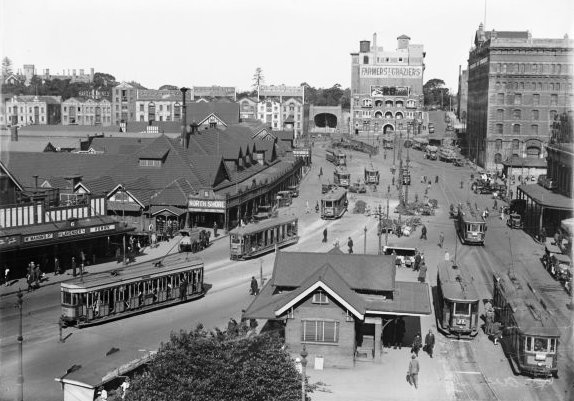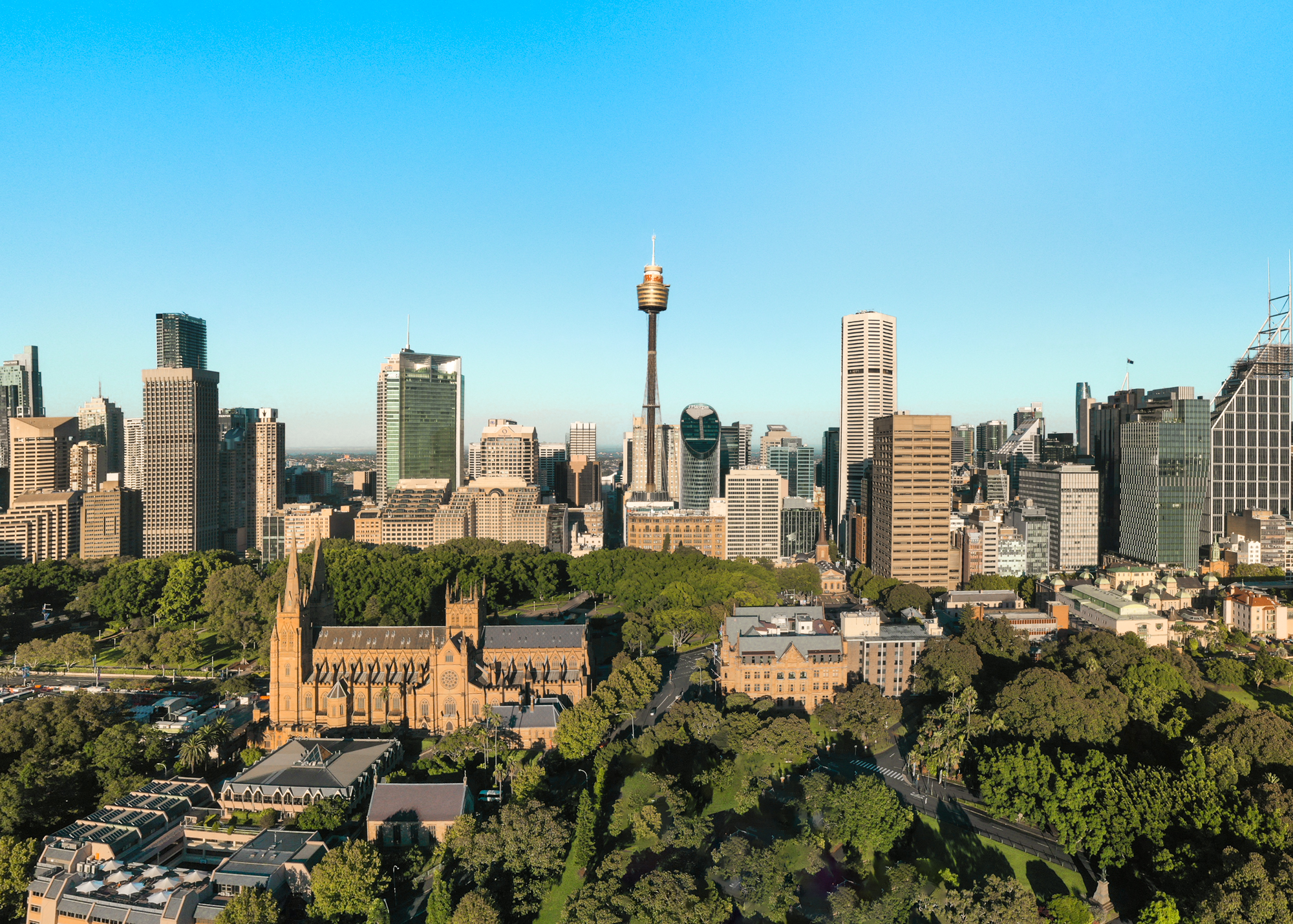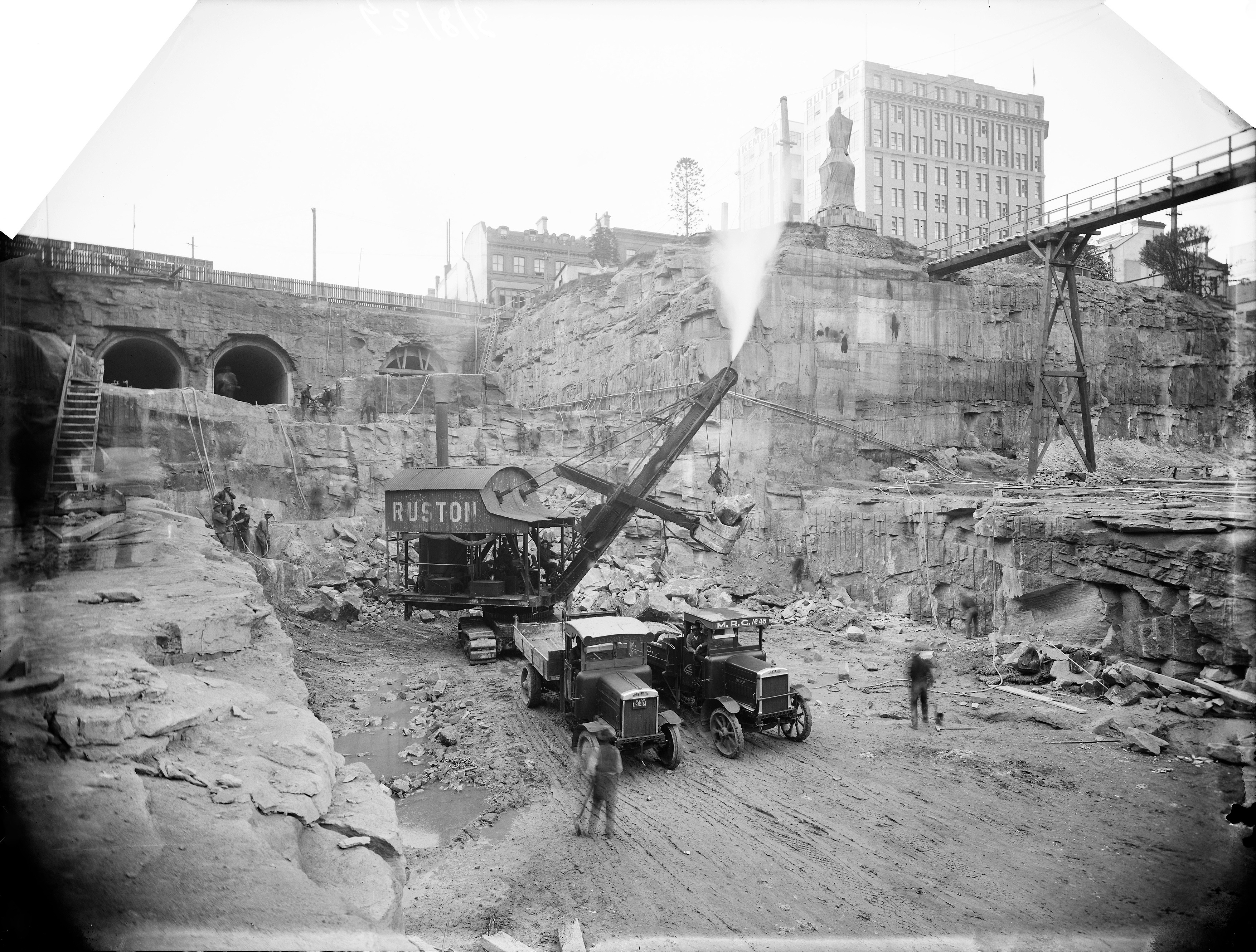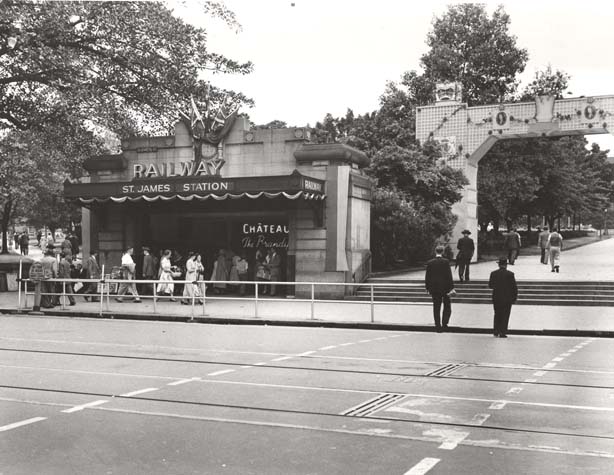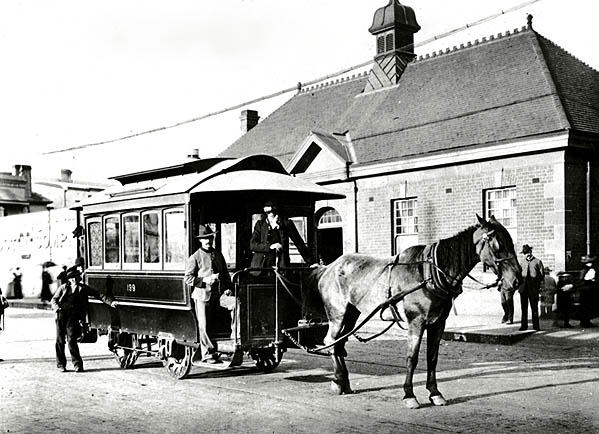|
Circular Quay Railway Station
Circular Quay railway station is a heritage-listed elevated commuter rail station that is located on the City Circle route, serving the Circular Quay precinct of the Sydney central business district in New South Wales, Australia. It is served by Sydney Trains T2 Inner West & Leppington, T3 Bankstown and T8 Airport & South line services. History Circular Quay is an area of historical significance for Sydney, as it was for a long time the central harbour of a settlement which relied on shipping for its connection to the outside world. By the 20th century, ferry commuter wharves began to eclipse commercial shipping wharves as the dominant feature of the Quay area. The area became a transport hub as it served as the terminus of both ferry and tram services. Planning for a railway station here to complement this transport hub began in 1909, and work was authorised in 1915. Tunnels to link the surrounding stations to the future Circular Quay station were built from Central betwe ... [...More Info...] [...Related Items...] OR: [Wikipedia] [Google] [Baidu] |
Sydney Central Business District
The Sydney central business district (CBD) is the historical and main Central business district, commercial centre of Sydney. The CBD is Sydney's city centre, or Sydney City, and the two terms are used interchangeably. Colloquially, the CBD or city centre is often referred to simply as "Town" or "the City". The Sydney city centre extends southwards for about from Sydney Cove, the point of first European settlement in which the Regions of Sydney, Sydney region was initially established. Due to its pivotal role in Australia's early history, it is one of the oldest established areas in the country. Geographically, its north–south axis runs from Circular Quay in the north to Central railway station, Sydney, Central railway station in the south. Its east–west axis runs from a chain of parkland that includes Hyde Park, Sydney, Hyde Park, The Domain, Sydney, The Domain, Royal Botanic Gardens, Sydney, Royal Botanic Gardens and Farm Cove, New South Wales, Farm Cove on Port Jackson, S ... [...More Info...] [...Related Items...] OR: [Wikipedia] [Google] [Baidu] |
Bankstown Railway Line
The Bankstown railway line is a railway line serving the Canterbury-Bankstown and Inner West regions of Sydney between the stations of Sydenham and Lidcombe. History The line opened on 1 February 1895, branching from the Illawarra line from Sydenham to Belmore. The line was originally constructed as an alternative route for goods traffic on the main southern railway, with planners intending the line to eventually link up with the main line at Liverpool. The 1890s depression put this plan on hold; by the time funds became available again, it had been decided to make the Bankstown line a suburban-only line to service the growing population west of Canterbury. On 14 April 1909, the line was extended to Bankstown, with intermediate stations at Lakemba and Punchbowl. In 1916, the Metropolitan Goods Line was constructed, running parallel to Bankstown line from Marrickville to Campsie. On 16 July 1928, it was extended to Regents Park where it joined the Main South line via a ... [...More Info...] [...Related Items...] OR: [Wikipedia] [Google] [Baidu] |
Proposed Railways In Sydney
Various railway lines have been proposed for Sydney, Australia, including both heavy rail extensions to the existing network, and more recently proposals for metro style lines– one of which was completed in 2019. Pre-Bradfield Proposals Between the opening of the first railway in the Sydney area (Sydney-Parramatta, 1855) and the publication of the comprehensive Bradfield plan for expansion of the metropolitan railways, there were a number of other proposed railway schemes which did not proceed. Planning in the early 1880s for the route of the first stage of the Illawarra railway considered a route continuing south from Kogarah, crossing the George's River at Taren Point, then turning southwest to climb the gradual slope from the river to Sutherland. Opposition to this route by Thomas Holt MLC, who owned most of what is now the urban part of Sutherland Shire meant the railway had to take an indirect route via Hurstville, which necessitated the high-level crossing of George's ... [...More Info...] [...Related Items...] OR: [Wikipedia] [Google] [Baidu] |
Joseph Cahill
John Joseph Cahill (21 January 189122 October 1959), also known as Joe Cahill or J. J. Cahill, was a long-serving New South Wales politician, railway worker, trade unionist and Labor Party Premier of New South Wales from 1952 to his death in 1959. Born the son of Irish migrants in Redfern, New South Wales, Cahill worked for the New South Wales Government Railways from the age of 16 before joining the Australian Labor Party. Being a prominent unionist organiser, including being dismissed for his role in the 1917 general strike, Cahill was eventually elected to the Parliament of New South Wales for St George in 1925. After many years of backbench service, including a term outside of parliament, Cahill was eventually appointed Secretary for Public Works in 1941 and Minister for Local Government in the government of William McKell in 1944, where he led significant reforms of local government in the state, including establishing a Royal commission in 1945, and passing the lan ... [...More Info...] [...Related Items...] OR: [Wikipedia] [Google] [Baidu] |
Premier Of New South Wales
The premier of New South Wales is the head of government in the state of New South Wales, Australia. The Government of New South Wales follows the Westminster Parliamentary System, with a Parliament of New South Wales acting as the legislature. The premier is appointed by the governor of New South Wales, and by modern convention holds office by his or her ability to command the support of a majority of members of the lower house of Parliament, the Legislative Assembly. Before Federation in 1901 the term "prime minister of New South Wales" was also used. "Premier" has been used more or less exclusively from 1901, to avoid confusion with the federal prime minister of Australia. The current premier is Dominic Perrottet, the leader of the New South Wales Liberal Party, who assumed office on 5 October 2021. Perrottet replaced Gladys Berejiklian on 5 October 2021, after Berejiklian resigned as premier. List of premiers of New South Wales Statistics The median age of a premier ... [...More Info...] [...Related Items...] OR: [Wikipedia] [Google] [Baidu] |
Cahill Expressway Construction
Cahill (, or ) is a name of Irish origin. It is the anglicised version of the Gaelic "Ó Cathail" meaning "descendant of Cathal". "Cathal" consists of two parts: "cath" means battle; the second could be "val" (rule), so that the name as a whole meant "battle ruler" or "strong in battle", or it could be "all" (great), so that the name as a whole meant "great warrior". People with the surname Notable people with the surname include: * Barry Cahill (actor) (1921–2012), Canadian-born actor *Kymba Cahill (radio announcer) (born 1980) Australian radio announcer * Barry Cahill (Gaelic footballer) (born 1981), Irish Gaelic football player * Bernard J.S. Cahill (1866–1944), American architect and cartographer * Brendan J. Cahill (born 1963), American catholic bishop * Charles Cahill (ice hockey) (1904–1954), Canadian ice hockey player * Charles Cahill (rugby league) (1916–2007), Australian rugby league footballer and coach * Christina Cahill (''née'' Boxer, born 1957), B ... [...More Info...] [...Related Items...] OR: [Wikipedia] [Google] [Baidu] |
Chullora Railway Workshops
Chullora Railway Workshops were a major workshops for the repair and heavy maintenance of locomotives and rolling stock for the New South Wales Government Railways. It was built on site at Chullora over 485 acres adjoining the main Sydney marshalling yards at Enfield. The decision to build a new workshop was made because of the inadequacy of the existing facilities at Eveleigh Railway Workshops and the decision to electrify the Sydney metropolitan network.Chullora Railway Workshops Department of Environment & Heritage The master plan envisaged it would cover all aspects of railway operation with separate facilities for a locomotive workshop, carriage workshop, wagon repair depot, electric repair shop, signal engineers branch, general railway store, water supply and exi ... [...More Info...] [...Related Items...] OR: [Wikipedia] [Google] [Baidu] |
World War II
World War II or the Second World War, often abbreviated as WWII or WW2, was a world war that lasted from 1939 to 1945. It involved the vast majority of the world's countries—including all of the great powers—forming two opposing military alliances: the Allies and the Axis powers. World War II was a total war that directly involved more than 100 million personnel from more than 30 countries. The major participants in the war threw their entire economic, industrial, and scientific capabilities behind the war effort, blurring the distinction between civilian and military resources. Aircraft played a major role in the conflict, enabling the strategic bombing of population centres and deploying the only two nuclear weapons ever used in war. World War II was by far the deadliest conflict in human history; it resulted in 70 to 85 million fatalities, mostly among civilians. Tens of millions died due to genocides (including the Holocaust), starvation, ma ... [...More Info...] [...Related Items...] OR: [Wikipedia] [Google] [Baidu] |
Wynyard Railway Station, Sydney
Wynyard railway station () is a heritage-listed underground commuter rail station located in the north-west precinct of the Sydney central business district, in New South Wales, Australia. The station opened on 28 February 1932 to coincide with the opening of the Sydney Harbour Bridge. History The station opened on 28 February 1932. Wynyard was originally constructed with six platforms (the existing four platforms are still numbered from 3 to 6), with platforms 1-4 located on the upper level and platforms 5 and 6 on the lower level. The original intention was that Platforms 1 and 2, located adjacent to platforms 3 and 4, would eventually serve the eastern pair of railway tracks across the Harbour Bridge for a proposed railway line to the Northern Beaches. In the interim, with construction yet to begin on the Northern Beaches line due to lack of funds, they were used as a terminus for North Shore tram services on Sydney's tram network, a service that operated over those tra ... [...More Info...] [...Related Items...] OR: [Wikipedia] [Google] [Baidu] |
St James Railway Station, Sydney
St James railway station is a New South Wales State Heritage Register, heritage-listed underground commuter rail railway station, station that is located on the City Circle, at the northern end of Hyde Park, Sydney, Hyde Park in the Sydney central business district of New South Wales, Australia. It is served by Sydney Trains Inner West & Leppington Line, T2 Inner West & Leppington, Bankstown railway line, T3 Bankstown & Airport & South Line, T8 Airport & South line services. It is named after the nearby St James' Church, Sydney, St James' Church and provides a direct link to the Sydney Airport International Airport railway station, Sydney, international and Domestic Airport railway station, Sydney, domestic railway stations. It was added to the New South Wales State Heritage Register on 2 April 1999. History Part of the Proposed railways in Sydney#Bradfield railway scheme, 1920s, Bradfield Plan, St James station was originally intended to be a major interchange with the East ... [...More Info...] [...Related Items...] OR: [Wikipedia] [Google] [Baidu] |
Trams In Sydney
The Sydney tramway network served the inner suburbs of Sydney, Australia from 1879 until 1961. In its heyday, it was the largest in Australia, the second largest in the Commonwealth of Nations (after London), and one of the largest in the world. The network was heavily worked, with about 1,600 cars in service at any one time at its peak during the 1930s (cf. about 500 trams in Melbourne today). Patronage peaked in 1945 at 405 million passenger journeys. Its maximum street trackage totalled 291 km (181 miles) in 1923. History Early tramways Sydney's first tram was horse-drawn, running from the old Sydney railway station to Circular Quay along Pitt Street.''The 1861 Pitt Street Tramway and the Contemporary Horse Drawn Railway Proposals'' Wylie, R.F. Australian Railway Historical Society Bulletin, February, 1965 pp21-32 Built in 1861, the design was compromised by the desire to haul railway freight wagons along the line to supply city businesses and return cargo from the ... [...More Info...] [...Related Items...] OR: [Wikipedia] [Google] [Baidu] |
